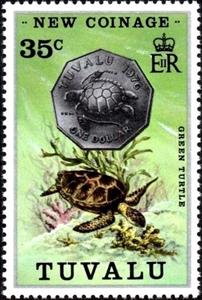Stamp: $1 Coin, Green Sea Turtle (Chelonia mydas) (Tuvalu 1976)
$1 Coin, Green Sea Turtle (Chelonia mydas) (Tuvalu 1976)
21 April (Tuvalu ) within release New coinage goes into circulation Stamp $1 Coin, Green Sea Turtle (Chelonia mydas) face value 35 Tuvaluan cent
| Stamp $1 Coin, Green Sea Turtle (Chelonia mydas) in catalogues | |
|---|---|
| Michel: | Mi:TV 22 |
| Stamp Number: | Sn:TV 22 |
| Yvert et Tellier: | Yt:TV 22 |
Stamp is square format.
Also in the issue New coinage:
- Stamp - 50c Coin, Atlantic Longarm Octopus (Macrotritopus defilippi) face value 5;
- Stamp - 10c-coin, Red-eyed Crab (Eriphia ??) face value 10;
- Stamp - 20c-coin, Flyingfish (Cypselurus sp.) face value 15;
- Stamp - $1 Coin, Green Sea Turtle (Chelonia mydas) face value 35;
Stamp $1 Coin, Green Sea Turtle (Chelonia mydas) it reflects the thematic directions:
A coin is a small object, usually round and flat, used primarily as a medium of exchange or legal tender. They are standardized in weight, and produced in large quantities at a mint in order to facilitate trade. They are most often issued by a government. Coins often have images, numerals, or text on them. The faces of coins or medals are sometimes called the obverse and the reverse, referring to the front and back sides, respectively. The obverse of a coin is commonly called heads, because it often depicts the head of a prominent person, and the reverse is known as tails.
Marine life, or sea life or ocean life, refers to the plants, animals and other organisms that live in the salt water of the sea or ocean, or the brackish water of coastal estuaries. At a fundamental level, marine life helps determine the very nature of our planet. Marine organisms produce much of the oxygen we breathe. Shorelines are in part shaped and protected by marine life, and some marine organisms even help create new land. Altogether there are 230,000 documented marine species, including over 16,000 species of fish, and it has been estimated that nearly two million marine species are yet to be documented. Marine species range in size from the microscopic, including plankton and phytoplankton which can be as small as 0.02 micrometres, to huge cetaceans (whales, dolphins and porpoises) which in the case of the blue whale reach up to 33 metres (109 feet) in length, being the largest known animal.
Turtles are reptiles of the order Testudines, characterized by a special shell developed mainly from their ribs. Modern turtles are divided into two major groups, the Pleurodira (side necked turtles) and Cryptodira (hidden necked turtles), which differ in the way the head retracts. There are 360 living and recently extinct species of turtles, including land-dwelling tortoises and freshwater terrapins. They are found on most continents, some islands and, in the case of sea turtles, much of the ocean. Like other amniotes (reptiles, birds, and mammals) they breathe air and do not lay eggs underwater, although many species live in or around water.



